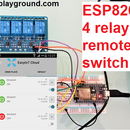Introduction: Low Power Door/window Sensor
In this manual we will show how to create cheap, secure door/window sensor network. We could monitor our door/windows status from desktop computer or mobile phone in web browser. Properly configured sensor could work between 5 and 10 years on 2 AA batteries. Power consumption of this sensor is so low that I'm using wasted batteries from electronic toys and sensor still work. You can use up to 254 sensors per one server.
See more tutorials at http://iot-playground.com/build
Step 1: Materials
EasyIoT server:
Raspberry Pi
NRF24L01+ module
USB power supply
Sensor node (up to 254 sensors per one server)
Arduino Pro Mini (Hacked for low power consumption)
NRF24L01+ module
1M resistor
AA battery holder
Magnetic door/window reed switch
Step 2: EasyIoT Server
Connect Raspberry Pi and NRF24L01 transceiver.
Download EasyIoT server image and copy it to SD card. EasyIoT server download. Windows users can write EasyIoT server image to SD card with Win32 Disk Imager.
Step 3: Door/window Sensor
Connect Arduino Pro Mini NRF24L01+, batteries and reed relay. For extra low power consumption follow Arduino low power.
After connection all wires program arduino with this sketch. Make sure that NRF24L01 channel and speed is the same as later used in EasyIoT server (see MyConfig.h file for settings).
Step 4: Configure
Power on Raspberry Pi and go in Web browser on computer (Raspberry Pi and computer must be on the same network). In browser type Raspberry Pi IP address. When asked for username and password use: admin and test.
In Web browser go to Configure->Drivers->MySensors->MySensors Driver and then Add Node. Now you power on your new sensor. If you are successful you should see new sensor address (no timeout message). After that create new group Configure->Groups and Modules->Add Group. Add new group and go in newly created group. Now add new sensor. After that you should see new sensor in main page. You can add up to 254 sensors.
Step 5: Mount Sensor
Place sensor to door or window.
Step 6: Monitor
Monitor door/window status from everywhere. If you enabled logging database you can also see door/window status history.

Participated in the
First Time Author Challenge











